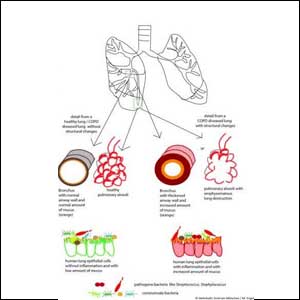- Home
- Editorial
- News
- Practice Guidelines
- Anesthesiology Guidelines
- Cancer Guidelines
- Cardiac Sciences Guidelines
- Critical Care Guidelines
- Dentistry Guidelines
- Dermatology Guidelines
- Diabetes and Endo Guidelines
- Diagnostics Guidelines
- ENT Guidelines
- Featured Practice Guidelines
- Gastroenterology Guidelines
- Geriatrics Guidelines
- Medicine Guidelines
- Nephrology Guidelines
- Neurosciences Guidelines
- Obs and Gynae Guidelines
- Ophthalmology Guidelines
- Orthopaedics Guidelines
- Paediatrics Guidelines
- Psychiatry Guidelines
- Pulmonology Guidelines
- Radiology Guidelines
- Surgery Guidelines
- Urology Guidelines
COPD: Changes in the lungs, changes in the microbiome

Coughing, breathing difficulties, and strong mucous production in the lungs are typical symptoms of COPD. The disease is often triggered by smoking, and, according to estimates from the World Health Organization (WHO), it could become the world's third most common cause of death in 2030. "COPD has various subtypes that, for example, can be verified by use of quantitative computer tomography (qCT)," explains PD Dr. Wolfgang zu Castell, head of the Research Unit Scientific Computing (ASC) at the Helmholtz Zentrum München. "We wanted to investigate if the microbiome in the lungs changes in a way that depends on these subtypes," adds Prof. Dr. Michael Schloter, head of the Research Unit for Comparative Microbiome Analyses (COMI) at the Helmholtz Zentrum München.
Microbiome and CT scans analyzed
For this purpose, scientists from the two research units examined samples gathered from nine healthy individuals and 16 COPD patients. They were all participants of a Europe-wide population study (EvA Consortium; Emphysema versus Airways Disease). On the one hand, CT scans were used to analyze the lungs and assign the patients to the respective COPD subtypes. On the other hand, the scientists used brush samples from lungs to determine the composition of the lung microbiome using certain marker genes.
"This allowed us to show that the composition of the bacterial community in the lungs of COPD patients without structural changes is very similar to that of healthy subjects," explains Dr. Marion Engel, scientist in the Complex Systems Research Group in the ASC and the study's first author. "On the other hand, the bacterial composition in the lungs of ill subjects with structural changes differ significantly from those of the other two groups, regardless of the severity of the disease."
Streptococci suspected
According to the study, Streptococci are often found in structurally altered lungs. This genus includes many pathogenic representatives that are also often detected in the presence of exacerbations. In the lungs of healthy subjects, on the other hand, there was an increased presence of the genus Prevotella, to which a number of probiotic characteristics have also been attributed.
Taken together, these findings indicate that for certain subtypes of COPD, changes occur in the bacterial communities in the lungs that can promote an increase of potentially pathogenic bacteria. With regards to personalized medicine, it would therefore be expedient also to keep an eye on the microbiome, for instance when considering whether or not antibiotics or glucocorticoids should be administered in the event of a particular COPD subtype
Read the full article click on the following link : Marion Engel, David Endesfelder, Brigitte Schloter-Hai, Susanne Kublik, Michael S. Granitsiotis, Piera Boschetto, Mariarita Stendardo, Imre Barta, Balazs Dome, Jean-François Deleuze, Anne Boland, Joachim Müller-Quernheim, Antje Prasse, Tobias Welte, Jens Hohlfeld, Deepak Subramanian, David Parr, Ivo Glynne Gut, Timm Greulich, Andreas Rembert Koczulla, Adam Nowinski, Dorota Gorecka, Dave Singh, Sumit Gupta, Christopher E. Brightling, Harald Hoffmann, Marion Frankenberger, Thomas P. Hofer, Dorothe Burggraf, Marion Heiss-Neumann, Loems Ziegler-Heitbrock, Michael Schloter, Wolfgang zu Castell. Influence of lung CT changes in chronic obstructive pulmonary disease (COPD) on the human lung microbiome. PLOSONE, 2017; 12 (7): e0180859 DOI: 10.1371/journal.pone.0180859

Disclaimer: This site is primarily intended for healthcare professionals. Any content/information on this website does not replace the advice of medical and/or health professionals and should not be construed as medical/diagnostic advice/endorsement or prescription. Use of this site is subject to our terms of use, privacy policy, advertisement policy. © 2020 Minerva Medical Treatment Pvt Ltd